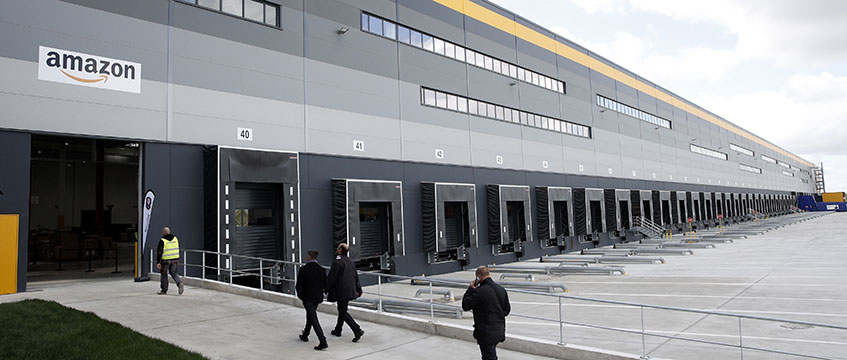Amazon on robots and logistics
Mapic 2018: Amazon has set out its plans for growth through robotics and travel hubs, while rising costs and infrastructure networks were highlighted as some of the issues affecting etail occupiers in Europe.
Taking part in a panel discussion at Mapic 2018 alongside executives from Zalando and logistics firm Kuehne + Nagel, Ronan Bole, director of operations in France at Amazon and president of Amazon France logistics, outlined the online giant’s strategy in the country.
The rise of the robots
Amazon is currently served by five fulfilment centres in France, with a sixth to open in Brétigny-sur-Orge, in the south of Paris. This will be the online giant’s first Holiday101robotics site in the country.
Mapic 2018: Amazon has set out its plans for growth through robotics and travel hubs, while rising costs and infrastructure networks were highlighted as some of the issues affecting etail occupiers in Europe.
Taking part in a panel discussion at Mapic 2018 alongside executives from Zalando and logistics firm Kuehne + Nagel, Ronan Bole, director of operations in France at Amazon and president of Amazon France logistics, outlined the online giant’s strategy in the country.
The rise of the robots
Amazon is currently served by five fulfilment centres in France, with a sixth to open in Brétigny-sur-Orge, in the south of Paris. This will be the online giant’s first Holiday101robotics site in the country.
The advantages of this are clear – according to Bole, robots will increase Amazon’s storage capacity for items per square metre by 50%, unlocking more of its existing warehouse space.
Currently, there are more than 25 Amazon robotic centres across the world. The etail giant estimates more than 10,000 of its 80,000 employees across Europe will work with robots at its centres by the end of 2018.
Despite its rapidly expanding fleet of robots, Bole denied that Amazon ultimately aims to replace its human workers.
He insisted there are a “lot of people in our fulfilment centres” to pair alongside its robots.
“We will continue to create jobs,” he said. “This year in France we will create 2,000 long-term jobs, to reach 7,500 by the end of the year.”
Bole predicted there will be 1,000 hires in the next three years to accompany the robots at the new site.
He said: “Even during peak season, in November and December, we will hire 7,000-8,000 people for temporary work that will become, at the start of next year, long-term contracts.”
While automation has not yet become the norm among retailers, Amazon is among those that have thrown down the gauntlet.
More etailers are joining the race to deliver goods to customers more rapidly through robotics.
Raimund Paetzmann, vice president of corporate real estate at Zalando, also told delegates the fashion ecommerce company is developing and testing robotics at its facilities.
Pioneering initiatives
Outside of automation, Amazon is making an effort to expand across France’s railway network, having signed an agreement with SNCF Gares et Connexions to install 1,000 lockers in train stations over the next three years. He also pointed to other well-documented innovations, including deliveries into car boots and to apartment buildings.
And now that Amazon’s business in France has achieved significant scale –its five existing centres measure some 350,000 sq m (3.8m sq ft) – each of its sites are specialised by product type. One handles large items, and another in shoes and clothing; the remaining three deliver everyday products.
Having developed a “spine” of large fulfilment centres from the north to the south of France, Amazon is now targeting expansion to cover regions in the east and west.
Demand for locations with infrastructure
As the industry shifts to respond to shifting expectations for customer experience, panellists also set out their observations on how real estate requirements for occupiers have changed.
Matthew Whittaker, business director of UK contract logistics at Kuehne + Nagel, noted that sheds have become “higher and larger”.
“There are areas of polarisation,” he added. “We are seeing mega fulfilment centres supported by more of an infrastructure network.”
However, there is a lack of supply – Whittaker highlighted the lack of infrastructure support in countries with more mature ecommerce markets as a pressing issue for logistics companies.
Changing occupier approaches to real estate
Soaring rents in the sheds sector has also prompted occupiers to rethink their approach to warehousing in other ways.
As part of its real estate strategy, Zalando is considering how to approach the issue of rising logistics costs by adopting new key performance indicators, including occupancy cost ratios (a rent-to-sales ratio).
Paetzmann said: “It is an interesting measure that we are starting to look into – it [is increasingly] part of the game, and logistics costs are increasing – real estate is becoming more expensive. [We are] setting up some KPIs.”
He also noted that while Zalando has a leasehold strategy, he pointed to the ongoing movement in ecommerce to “get rid of the intermediate” by reaching out directly to investors, largely through leaseback arrangements, but only “in certain areas”.
“It is interesting for us and we [are starting] to negotiate with [our] partners,” Paetzmann said.
To send feedback, e-mail pui-guan.man@egi.co.uk or tweet @PuiGuanM or @estatesgazette











